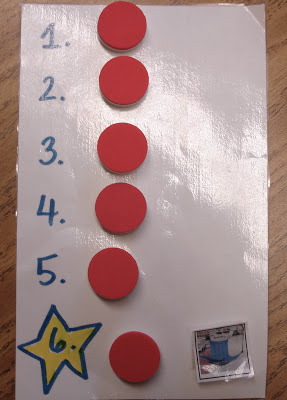A binder based schedule and work system (say that 10x fast!)
Fellow School-based SLPs/ Parents/ Teachers/ Etc… do you any of you ever wonder if your job is transforming from SPEECH Pathologist to behavior specialist? I sure do. It takes up a large portion of my every day at school, and thoughts at home.
I recently created a work system and mini-schedule for one of the students on my caseload who refuses to enter her classroom. Several colleagues have said that this information would be useful to others, so I’m sharing with the cyber world… (Please note, all identifying information has been changed).
JM’s binder—to be kept with JM during all times of the day
Contents:
Rating form data collection
Mini Schedule
Task folder(s)
Picture Icons
Work to do
Details:
1. Rating form data collection should be kept in inside pocket. It needs to be filled out approximately every 30 minutes. If she is not with HER regular group, then it is an automatic 0. The other data points are whether she follows her mini schedule, and if she does her work.
2. Mini Schedule: 2 velcro strips. The white strip should always contain the jobs she is to do for the immediate time being. For example, Walk to Speech (picture of walk, picture of Speech), Do task folder 1 (picture of 1), then break (picture of smiley break).
Before beginning each mini schedule, give JM a few reasonable choices of breaks. Things she enjoys are: coloring, crafts, taking walks, going outside, computers (sometimes), playing with dolls. Only offer things that you are able to do during that time period. If JM chooses a break that requires materials (such as a coloring activity), get those materials BEFORE she begins the task so that she knows she can have her break immediately upon finishing the task.
The mini schedule is meant to encompass 15-30 minutes of activity total. So if you are with her for 30 minutes, you can expect to go through the entire schedule 1-2 times. In the beginning we are expecting only 1 task folder and only 5 minutes of work before she gets break. As appropriate, we will add more task folders (pictures of 1, 2, 3, etc.) before the break. OR the amount in each task folder can be increased, as she is able to do the work.
As JM does each thing, she moves it to the pink side. So, when she finishes WALKing to speech she can move over both walk and speech. When she finishes the task #1, she can move that over. When the only thing left is break, she gets a break.
3. Task Folder: Should contain ONLY what you expect JM to actually do. Do not put in an entire packet of materials. Put in one page (or 2 if you expect that to be done in one sitting). If the task is too big to put into the folder (such as a puzzle), draw a picture of it and put that inside to represent puzzle.

Upon completion of the task, JM can put the paper in the “finished” side of the task folder.

4. Picture Icons: There are many picture icons in the back of this file. Use ones that seem appropriate. Whenever a task is required, try to use the numbers corresponding (1, 2, 3) so that they are very concrete and not just an abstract “work”. Please let SLP know if additional icons are needed. In a pinch, post-its with a picture and word are a great fill-in for a picture that you cannot find.

5. Extra work: In the back pocket keep extra work for JM to do at a later point. That way the extra work is kept available at all times, but is NOT in the task folder overwhelming her. (Please ask teacher or Sped teacher for a variety of work items to keep back there). Also note, teacher has a tub of academic materials in the classroom in the computer desk to the right of the door when entering classroom.

Other info:
Headphones: Should be available to JM ALL day long. From the moment she enters school until she leaves (take them before she gets on the bus and return with binder at the end of the day). She does not have to wear them, but they should be an option.

Leaving the designated area: At this time, our goal is to keep JM safe. Follow her, or if that is not possible, call the office immediately to have someone else keep her in line of sight. Show her the binder and remind her of what she is supposed to be doing (this is probably a task and is probably why she left the designated are). Use as little verbal language as possible—point instead of talking. The language you should be using is “First work, then break.” Repeat it over and over if necessary. Offer choices: “Do you want to work in the hall or in resource room?”, “Do you want to work in the classroom or the Speech room?”, etc. If nothing can coax her into either returning to her designated place or doing her work, let her sit and keep her in line of sight.
There you go. I hope this is helpful to others. I kinda, sorta, really wish I had seem a good model of this 10 years ago. Instead of having to create my own version in the midst of a crisis.








Yeeeeeees. I also made a fancy Velcro schedule for a kid last week. The teachers aren’t using it. I am the saddest SLP.
I can think of a teacher who could really use this. Thanks!
This is fabulous! I might have to use it for one of my kiddos. Thanks so much for sharing!
Fantastic! And yes, I specifically went back to school to get my cert in ABA for this VERY reason. I was not given ANY training in grad school regarding behavior! I learned a LOT on the job, and then worked with an A M A Z I N G BCBA who inspired me to go get more education. *Someday* I hope to be a BCBA also!
Now…if only they would lower the caseloads in the schools to manageable numbers so that we could actually implement the best behavior strategies…
I agree that we should have to take behavior management courses in school. Most of us just seem to learn on the job. This is a great system CC. Thanks for sharing.
Thank you so much for sharing this! My daughter suffers from autism and this sounds like it would be so helpful. I also found a lot of help learning about autism from http://onlineceucredit.com/edu/social-work-ceus-fl. I hope this is helpful!